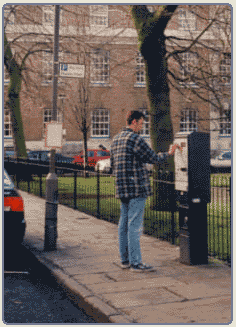


 



  
|

Taxonomy and description
Terminology
Technology
 Terminology Terminology
Parking controls are applied to on and off street parking (multistorey,
ground level and underground), although the style of control will vary
with the type of parking space. The ability to apply controls will also
depend on local legislation. Types of parking space fall into the following
categories:
- Public spaces
- On-street
- Off-street, operated by local authorities or private companies
- Private spaces (off street)
- Residential
- Non-residential
Parking controls can take a number of forms, including duration, cost,
time of day, supply, location of spaces, permits and parking bans. Parking
charges will be considered separately from the other controls considered
here. The application of controls to existing private spaces can be very
difficult for local authorities, as they generally do not have any jurisdiction
over parking that is not for public use. PNR parking is most easily controlled
through the planning process and is considered in more detail under Parking
Standards for New Developments. Additionally, legislation may
be required to apply other controls, such as restricting on street areas
to residents only parking.
| Duration Controls |
| Duration controls relate to the length of time a vehicle can be
parked in a public space. The most basic categorisation is long or
short stay parking. Short stay spaces (usually less than half a day)
are generally nearest to town and city centres and on-street or relatively
small ground level car parks. Where demand significantly outstrips
supply parking may be limited to two hours (or as little as 20 minutes),
with return prohibited with a specified period (often two hours) and
high charges applied. Short stay spaces are most often local authority
owned and controlled. Long stay spaces (generally half a day or more)
are often on the outskirts of the city centre, off-street and larger
(either multistorey or underground) in comparison to short-stay car
parks. Duration is controlled through manual enforcement (fines) by
the local police, traffic wardens or private companies employed by
the local authority. Whether spaces are free or charged, duration
controls will only work where drivers perceive the risk of being fined
to be high and the fine to be high enough to deter them from ignoring
duration restrictions. |
| Time of Day Controls |
| Time of day controls are used to dictate when parking is permitted
and when other controls apply. In areas with high traffic flows during
the day, on street parking may only be permitted off-peak. It is common
for duration controls and charges to be more restrictive during peak
hours, and possibly not apply at all during some off-peak hours. Duration
controls and charges may apply between 08:00 and 18:00, but not over
night for example. Time of day controls are also used to regulate
when permits are required. For example, in an inner city residential
area, duration and charge controls may apply during the day, but parking
is restricted to residents with permits only between 18:00 and 08:00. |
| Supply and location |
| Supply of parking influences the volume of traffic attracted to
an area. If drivers cannot be sure of a parking space, they may use
a different mode or change destinations. However, limiting supply
in popular destination areas may simply increase the amount of search
traffic in that area if parking is not provided elsewhere or alternative
modes are not made available. For example, planners may want to keep
cars out of city centres to improve the environment for pedestrians
(shoppers), so spaces may be taken out of action in the centre, but
more provided around the fringes. Use of park and ride may also be
encouraged to keep cars out of town completely. Conversely, in areas
seeking to make themselves more attractive to visitors, parking supply
may be increased. The location of new parking is also important. New
parking should be provided in areas where the negative impacts of
increased traffic volumes will be least severe, for example near to
a main road entering a city, as opposed to back street locations. |
| Permits and Dedicated Spaces |
| Permits are used to regulate who can park in a space. In residential
areas it is common for on-street parking to be for resident permit
holders only, although it is possible for local businesses to apply
for these permits in some countries. Disabled drivers also hold permits
allowing them to deviate from parking controls or use dedicated spaces.
Holders of such permits can often park where others are not allowed
or in short stay spaces for any duration without a charge. Additionally,
large car parks often have dedicated spaces near to payment machines
and pedestrian entrances solely for use by disabled drivers. Others
who may hold permits allowing them to deviate from parking controls
include medical and social services staff who may need to park in
residential areas, and trades people who may need to park in these
areas as well as city centres near to business premises they are contracted
to. Delivery vehicles may also hold permits allowing them to enter
controlled zones, even pedestrianised areas, at particular times –
often over night. Taxi ranks are also a form of dedicated space. Permits
effectively make parking spaces dedicated to specific users for all
or part of a day. |
| Parking Bans |
| Bans are used to prevent on street parking in areas where the road
capacity is insufficient to allow parking and maintain traffic flow,
or where parking can contribute to accidents. Streets and areas subject
to parking bans are identified through street markings and traffic
signs. On the busiest streets, bans may be complete – i.e. no
stopping for any purpose, 24 hours per day. On other streets, bans
may be partial – peak hours only for example. The type of ban
can also vary; instead of complete bans, stopping to drop off/pick
up passengers or goods may be allowed. Parking may also be banned
on just one side of a street to provide parking and maintain traffic
flow, where the road width is insufficient to allow parking on both
sides and cars to pass. As with charges and duration, bans are implemented
through enforcement. |
The main focus here will be car parking and the traffic impacts that
controls result in. Nevertheless, parking controls also relate to, coaches,
lorries, motorcycles and bicycles. Bicycle parking is often near to destinations
(sometimes within pedestrianised areas) and away from heavily trafficked
areas to promote near door-to-door travel and safety. Bicycle parking
is generally free and relatively uncontrolled to promote use of this mode.
Although, bicycle parking may be banned in some locations due to safety
considerations (e.g. chaining bicycles to railings beside narrow footpaths).
Similarly, motorcycle parking is also relatively near to destinations,
but avoiding pedestrian areas, either on street or incorporated into car
parks. Control of motorcycle parking varies between locations. Some authorities
make no special provision and subject motorcycles to the same controls
as cars. Other authorities – often those seeking to encourage their
use instead of car travel – are more liberal. In these authority
areas, motorcycle parking may be subject to no more control than bicycles,
or they may have dedicated on-street spaces and reduced or no charges.
Lorry parking is also subject to control. Such parking is needed when
drivers on long haul journeys park over night or during rest breaks. Consequently,
access to city centres is not generally a requirement, but access to the
trunk road and motorway network is. Thus, lorry parks are generally on
the outskirts of cities or even in more rural areas (often near to industrial
estates to minimise visual intrusion) to keep large vehicles out of town
centres. Similarly, with coach parking there is a need to keep large vehicles
out of town. However, there is also a need for access to town centres
for passengers. Thus, coach parking is often integrated with larger car
parks just outside of city centres or at key destinations such as theatres.
Where coach parking is integrated with car parking, coaches will be subject
to the same controls.
Long stay parking is usually off street and further from destinations,
with lower charges the further away from town centres the car parks are.
This is designed to keep traffic out of town centres. Another source of
conflict is between commuters and residents. Residents want to be able
to park outside their house, but commuters often take spaces to avoid
parking charges where their work place does not provide parking for all
staff. Where space is available in residential streets it also allows
commuters to continue driving despite other measures to discourage car
use. Thus, residents' only parking is often introduced to tackle these
issues.
It is clear that parking policies establishing which type of parking
and control is used where and when, must be designed not only to tackle
traffic management issues, but also conflicting user needs.
 Technology Technology
Most forms of parking control now require some level of technological
input. Enforcement is usually through the issuing of fines, often via
a handheld terminal. These terminals operate on a similar basis to personal
digital assistants (PDAs), although they also include portable printers.
As with PDAs, the handheld terminals link to office based PCs to download
stored data. Specialised parking management systems are available to centrally
operate parking management. These systems control the recovery of fines
issued, tow away schemes, the issuing of permits, number and location
of spaces (sometimes real time), and any other aspect of parking management
the client specifies for custom built systems. Thus, even uncharged on-street
spaces subject only to a duration control require some technology. Where
charges are used as a means of control, payment collection technology
(on-street meters, in-car meters and smart cards, off-street pay-on-foot
kiosks and entry/exit ticket and payment machines) is required. Details
of this can be found under Parking Charges.
Technology also has a role in controlling entry and exit to car parks,
which can be combined with payment. Off-street parking is often subject
to these controls to issue tickets and regulate the volume of search traffic
within the car park. Sensors built into ticket machines identify vehicles
approaching a barrier or raised bollard, which triggers the issuing of
a ticket. When the driver takes the ticket, this raises the barrier or
depresses the bollard. The ticket machine then regulates the number of
vehicles entering the car park to prevent more cars entering than there
are spaces available. On exit from the car park, payment is collected
through the same process or a staffed kiosk. The machines are linked to
a central computer, which calculates the number of spaces available and
stores data on charges received.
 Increasingly,
entry and exit controls merely regulate the number of vehicles within
a car park; payment is by a pay-on-foot machine – drivers obtain
a ticket from a machine located near pedestrian exits as they leave, and
pay at the same machine on return. Tickets are then returned to the driver
who inserts them into an exit control machine to prove that payment has
been made. Increasingly,
entry and exit controls merely regulate the number of vehicles within
a car park; payment is by a pay-on-foot machine – drivers obtain
a ticket from a machine located near pedestrian exits as they leave, and
pay at the same machine on return. Tickets are then returned to the driver
who inserts them into an exit control machine to prove that payment has
been made.
Increasingly, real time technology also has a role in providing parking
information. It is now common for direction signs to indicate when a car
park is full, and in some cases, which alternative car parks have the
most spaces available. Full details are given under Parking
Information.

|




